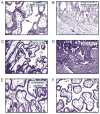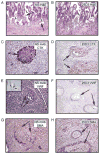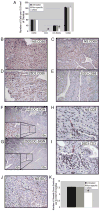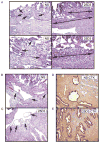Passive immunization against the MHC class I molecule Mamu-AG disrupts rhesus placental development and endometrial responses
- PMID: 18056344
- PMCID: PMC6191312
- DOI: 10.4049/jimmunol.179.12.8042
Passive immunization against the MHC class I molecule Mamu-AG disrupts rhesus placental development and endometrial responses
Abstract
The unique MHC phenotype of the human and nonhuman primate placenta has suggested a potential role in maternal-fetal immune tolerance, pregnancy success, and maternal as well as fetal well-being. In the rhesus monkey (Macaca mulatta) a nonclassical MHC class I molecule, Mamu-AG, is a putative homologue of HLA-G and is hypothesized to play a role in maternal-fetal immune interactions during pregnancy. Rhesus monkeys were passively immunized during the second week after implantation with a mAb against Mamu-AG. Passive immunization altered the growth and vascularization of the fetal placenta, the placental modification of maternal endometrial vessels, the maternal leukocyte response to implantation, and the differentiation of epithelial and stromal cells in the endometrium. These data are the first to demonstrate in vivo the importance of MHC class I molecules expressed on primate trophoblasts in establishing an important environment for pregnancy success through coordinated interactions between endometrial and fetal tissues.
Conflict of interest statement
The authors have no financial conflict of interest.
Figures







Similar articles
-
Placental expression of the nonclassical MHC class I molecule Mamu-AG at implantation in the rhesus monkey.Proc Natl Acad Sci U S A. 2000 Aug 1;97(16):9104-9. doi: 10.1073/pnas.97.16.9104. Proc Natl Acad Sci U S A. 2000. PMID: 10922066 Free PMC article.
-
The rhesus monkey analogue of human lymphocyte antigen-G is expressed primarily in villous syncytiotrophoblasts.Biol Reprod. 1998 Mar;58(3):728-38. doi: 10.1095/biolreprod58.3.728. Biol Reprod. 1998. PMID: 9510960
-
Identification of a novel MHC class I gene, Mamu-AG, expressed in the placenta of a primate with an inactivated G locus.J Immunol. 1997 Oct 1;159(7):3311-21. J Immunol. 1997. PMID: 9317129
-
Pregnancy initiation in the rhesus macaque: towards functional manipulation of the maternal-fetal interface.Reprod Biol Endocrinol. 2004 Jun 16;2:35. doi: 10.1186/1477-7827-2-35. Reprod Biol Endocrinol. 2004. PMID: 15200676 Free PMC article. Review.
-
The equine immune response to endometrial cups.J Reprod Immunol. 1997 Oct;34(3):203-16. doi: 10.1016/s0165-0378(97)00044-2. J Reprod Immunol. 1997. PMID: 9350637 Review.
Cited by
-
Trophoblast differentiation, invasion and hormone secretion in a three-dimensional in vitro implantation model with rhesus monkey embryos.Reprod Biol Endocrinol. 2018 Mar 16;16(1):24. doi: 10.1186/s12958-018-0340-3. Reprod Biol Endocrinol. 2018. PMID: 29548332 Free PMC article.
-
Pax6 is a human neuroectoderm cell fate determinant.Cell Stem Cell. 2010 Jul 2;7(1):90-100. doi: 10.1016/j.stem.2010.04.017. Cell Stem Cell. 2010. PMID: 20621053 Free PMC article.
-
Highly efficient maternal-fetal Zika virus transmission in pregnant rhesus macaques.PLoS Pathog. 2017 May 25;13(5):e1006378. doi: 10.1371/journal.ppat.1006378. eCollection 2017 May. PLoS Pathog. 2017. PMID: 28542585 Free PMC article.
-
KIR3DL05 and KIR3DS02 Recognition of a Nonclassical MHC Class I Molecule in the Rhesus Macaque Implicated in Pregnancy Success.Front Immunol. 2022 Mar 23;13:841136. doi: 10.3389/fimmu.2022.841136. eCollection 2022. Front Immunol. 2022. PMID: 35401580 Free PMC article.
-
Novel HLA-G-binding leukocyte immunoglobulin-like receptor (LILR) expression patterns in human placentas and umbilical cords.Placenta. 2008 Jul;29(7):631-8. doi: 10.1016/j.placenta.2008.04.007. Epub 2008 Jun 5. Placenta. 2008. PMID: 18538388 Free PMC article.
References
-
- McMaster MT, Librach CL, Zhou Y, Lim KH, Janatpour MJ, DeMars R, Kovats S, Damsky C, Fisher SJ. Human placental HLA-G expression is restricted to differentiated cytotrophoblasts. J Immunol. 1995;154:3771–3778. - PubMed
-
- Blaschitz A, Hutter H, Dohr G. HLA class I protein expression in the human placenta. Early Pregnancy. 2001;5:67–69. - PubMed
Publication types
MeSH terms
Substances
Grants and funding
LinkOut - more resources
Full Text Sources
Other Literature Sources
Medical
Research Materials

